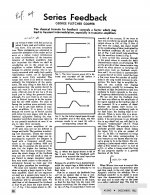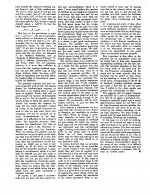Let's discuss it! Remember, this is before personal computers, almost before computer aided design, and even before silicon transistors became popular. In the early days, graphical techniques were often applied to get a better understanding of an electrical problem and this is an example that, at least to me, is quite revealing.
This could still apply to many circuits used in audio today.
THx-RNMarsh
This could still apply to many circuits used in audio today.
THx-RNMarsh
How would wider open loop BW and/or higher SR help in this?
THx-RNMarsh
How would wider open loop BW and/or higher SR help in this?
THx-RNMarsh
Makes absolutely no difference, until you have enough loopgain at 20kHz and slew rate is 5 - 10x higher than the dv/dt of the full scale output 20kHz sine wave. Exaggerating importance of these 2 parameters is only a marketing hype of the protagonists involved.
For the record, I won't help you unless paid, for quite obvious reasons. For more or less different reasons the same applies to a few others, but at least they have the decency not to suggest I should.
This the Royal 'we' John? You need to be careful. Waly has posted more of technical relevance than either you or Richard in the last 6 months. And that was only one post!
Dear Colleagues,Exaggerating importance of these 2 parameters is only a marketing hype of the protagonists involved.
I was told that people were very polite on Anglo-saxon forums, not aggressive, respecting others. In a word, well educated. ... One more fairy tail ?
And all this about what ?... Audio-electronic ! Oh, Lord !
I joined this forum in the hope to learn one or two things on a subject that passionate-me all my life, rest me from my studies on rocket science and share the little I know with gentlemen in a friendly atmosphere.
I don't think I will stay long.
Have a good day.
Tryphon Tournesol.
Attachments
Last edited:
... I don't think I will stay long.
That's not good, I really like that avatar. Mostly I'm lurking here, and sometimes I learn a bit, at other times I will make a stupid comment (like now), but most of the time [here] I will be wasting my time
Makes absolutely no difference, until you have enough loopgain at 20kHz and slew rate is 5 - 10x higher than the dv/dt of the full scale output 20kHz sine wave. Exaggerating importance of these 2 parameters is only a marketing hype of the protagonists involved.
OK. a more general question then is how do you remove entirely this issue brought up and described?
I have noted that CFA seem to dominate the high-end designs by many companies... and mid to lower models are VFA. still wondering why this is so. Now, I understand from others that DIYAudio's Lazy Cat (LC) has made a CFA amp after his very successful VFA and diy'ers seem to like it best. It always seems to be this way. Why?
THx-RNMarsh
Last edited:
Poking around on my computer, I found this article from 'Audio' magazine that is almost 55 years old and is almost a revelation in insight to the negative feedback problem, yet done so long ago---before Otala, Jung and just about everybody else who has had concerns about the secondary effects of negative feedback. Let's discuss it! Remember, this is before personal computers, almost before computer aided design, and even before silicon transistors became popular. In the early days, graphical techniques were often applied to get a better understanding of an electrical problem and this is an example that, at least to me, is quite revealing.
Totally wierd, the first page is missing many letters in Sumatra pdf reader? what is going on, is it a corrupted download, or does anyone else get that too?
Not here but it is an image, do you have a resolution issue?Totally wierd, the first page is missing many letters
Tournesol, this is the lounge. It is like a pub where people get into heated arguments.
There are many threads in the forum where less passionate discussions take place discussing technical aspects of design.
I suggest investigating those topics before deciding to leave.
There are many threads in the forum where less passionate discussions take place discussing technical aspects of design.
I suggest investigating those topics before deciding to leave.
I believe the PDF JC posted is what they call image with text. OCR may have been used to embed text data in order to allow copy and paste, or for speech synthesis. Some PDF readers may not fully support the format, or sometimes video drivers can cause problems depending on layers.
Hi TheGimp,
There are times when that is unavoidable. For what you are trying to do, just accept that a click will be produced. You can't change that unless you go with a timed "fade" with a semiconductor switch. Something I saw in a datasheet years ago. Maybe Analog Devices with a "DG" series part number. Sorry I can't remember this better, but it was probably about 30 years ago now.
-Chris
There are times when that is unavoidable. For what you are trying to do, just accept that a click will be produced. You can't change that unless you go with a timed "fade" with a semiconductor switch. Something I saw in a datasheet years ago. Maybe Analog Devices with a "DG" series part number. Sorry I can't remember this better, but it was probably about 30 years ago now.
-Chris
Cooper's paper insists that all amplifiers using series feedback MUST exhibit overshoot when driven with square wave inputs. But I and many others have built amplifiers whose open loop phase margin is 80 degrees and whose closed loop square wave response exhibits no overshoot at all. This is not even difficult. For a quick one-hour proof in the lab, connect up an externally compensated opamp as a gain-of-plus-ten noninverting amplifier, and choose an external compensation which gives more than 83 degrees of phase margin. Suitable candidates are the NE5534A {the single, not the dual} , the LM301 , and others. Ain't no ringing there, mister.
Hi TheGimp,
Filter the audio and follow the bass line. Still, sounds like a complicated circuit just to flip phase. Maybe shorting the signal to ground momentarily during the changeover might sound better. That doesn't require any look at the audio signal. One thing is for sure, the signal you are leaving and it's opposite phase will have a worst case discontinuity. That is the definition of an inverted signal.
You could use a 4066 or 4966 (higher voltage part) to take the signal to ground, but would have to figure out the release time depending on how long the relay takes to cycle. This is at least something you can do.
-Chris
Filter the audio and follow the bass line. Still, sounds like a complicated circuit just to flip phase. Maybe shorting the signal to ground momentarily during the changeover might sound better. That doesn't require any look at the audio signal. One thing is for sure, the signal you are leaving and it's opposite phase will have a worst case discontinuity. That is the definition of an inverted signal.
You could use a 4066 or 4966 (higher voltage part) to take the signal to ground, but would have to figure out the release time depending on how long the relay takes to cycle. This is at least something you can do.
-Chris
I got a blank ........I believe the PDF JC posted is what they call image with text. OCR may have been used to embed text data in order to allow copy and paste, or for speech synthesis. Some PDF readers may not fully support the format, or sometimes video drivers can cause problems depending on layers.
Cooper's paper insists that all amplifiers using series feedback MUST exhibit overshoot when driven with square wave inputs.
Does he submit any evidence?
Here are the two pages saved as JPG image files.
Uh - huh, I see. This is a popular, oversimplified paper.
- Status
- Not open for further replies.
- Home
- Member Areas
- The Lounge
- John Curl's Blowtorch preamplifier part II


